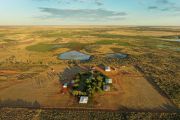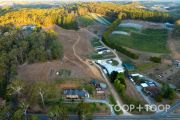
Thomas Foods puts Texas Downs on the menu
One of Australia’s largest food producers, Thomas Foods International, has put a holding of more than 5000 hectares in New South Wales’ Lower Darling region on the market.
Texas Downs spreads across 5278 ha and is operating as a mixed horticulture, viticulture and livestock operation. It includes 12.6 ha planted to citrus, 80 ha suitable for pivot irrigation and 12 ha which has been planted to wine grapes.
The holding is just eight kilometres from Menindee township. While the area around the Menindee Lakes has long grappled with an unpredictable water supply, Texas Downs has the benefit of a 550-megalitre High Security Darling water source.
The property includes a Western Lands Lease perpetual lease suited to agriculture and grazing.
CBRE’s Phil Schell and Angus Bills have been appointed to manage the sale process for the property which is expected to win offers of $2.5 million or more.
“Texas Downs represents an outstanding opportunity for existing producers in the horticulture sector seeking crop diversity and seasonal spread with earlier harvesting in the region,” Mr Bills said.
“The expansive modern infrastructure provides scope for production, packaging and distribution. The climate in the Menindee region is suited to growing many horticultural crops.”
Improvements on the property include a modern packing shed with multiple offices, a 500-square-metre cool room facility and a workshop area. The property has two homes supported by worker accommodation and farm sheds.
Texas Downs was originally part of the famed Tandou operation in the 1990s. Tandou was taken over by walnut producer Webster four years ago, in one of the biggest listed agricultural land and water plays in Australia’s history.
Texas Downs was once primarily planted to cotton but the operation has since been improved for horticulture pursuits.
Thomas Foods has been a rural buyer as much as a seller. Less than two years ago the Adelaide-based company scooped up one of South Australia’s most iconic sheep and cattle stations, Mt Schanck south of Mount Gambier for more than $50 million.
Rural property values are expected to remain in a holding pattern in 2019 until more rain comes.
Over 2018, the strongest performing sector was wine grapes where land values jumped 30 per cent to between $22,000 and $32,000 per hectare, according to Herron Todd White.











